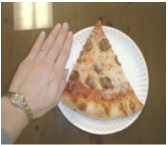Pizza and Blood Sugar Control: (Not Quite) Easy as Pie
.JPG)
Since the beginning of time, when cave people discovered the joys of combining cheese, sauce, and crust, people with diabetes have been perplexed on how to manage blood sugar levels when eating pizza. Things became even more complicated during the "toppings revolution" of the Renaissance, when folks started putting everything from salted fish to pineapple on their favorite pies.
Today, even with an assortment of new tools and techniques for managing blood sugar, the "pizza effect" continues to elude the masses. Many find it nearly impossible to figure out the carbs-per-slice, whether it be thin-crust, hand-tossed, or deep-dish. For some, indulging in a few slices results in an inexplicable blood sugar drop after eating, followed by a momentous sugar surge. For others, the blood sugar doesn't start to head skyward until many hours later, perhaps overnight.
For those who enjoy a slice (or two, or six...), here are three ideas that might help you find that delicate balance between the pizza you love and the healthy blood sugar you covet.
1. counting pizza carbs
To count the carbs in pizza, you'll need a hand. Your hand, to be exact. You can estimate the number of carbs in pizza pretty well by using your hand as a measuring tool. A traditional, hand-tossed pizza that is the size of the average adult's hand contains approximately 30g of carb. And don't forget to include the corners!

A traditional, hand-tossed pizza that is the size of the average adult's hand contains approximately 30g of carb. And don't forget to include the corners! In this example, the slice of pizza is slightly larger than an adult woman's hand, so we'll call it 35g.
An adult's hand-size slice of thin-crust? Go with 20g. Deep-dish, pan or Sicilian? Call it 45g. To see if your hand is larger or smaller than average, count the number of your "hands" in a frozen pizza that has a nutrient label or a slice from a restaurant or delivery company that provides nutrient listings for its food. Slice sizes can vary tremendously. I've seen pizza delivered by a national chain that was so small, the slices were barely half a hand, or 15g each. Then again, my favorite pizza shop on the boardwalk in Ocean City, NJ, is at least 2 ½ hands, or 75g carb.
2. delay the bolus
Sometimes, food doesn't digest all that quickly. Especially when it contains a great deal of fat, or you consume a lot of it at one time. Fat slows the rate at which food empties from the stomach into the intestines, where it is then absorbed into the bloodstream. Likewise, large volumes of food take longer to pass through the stomach than smaller quantities. If you consume multiple slices of pizza, or the pizza is laden with fat-filled toppings like sausage or extra cheese, you can expect the carbs to take a few hours longer than usual to "kick in".
When we give a bolus of rapid-acting insulin (either via injection or a pump), the insulin usually starts to work in about 15 minutes, peaks in 60-90 minutes, and finishes in about three to four hours. This activity profile works fine if the food you are eating digests fairly rapidly. When the food digests slowly, a normal meal bolus may peak too early – resulting in a blood sugar drop followed by a blood sugar rise a few hours later when the food is finally absorbed but the bolus is fading.
The solution is to delay or blunt the activity of the insulin. This can be accomplished a number of ways. The bolus could be taken after the meal instead of before. The dose can be split into two parts: half taken before eating, the other half taken an hour or two later (if you need a correction bolus for high blood sugar, always include all of it in the first injection). You could even use Regular (R) insulin instead of a rapid-acting analog. For those who use an insulin pump, the bolus can be delivered gradually over a few hours using the square/extended/dual/combination bolus feature. My personal preference is to give a third of the bolus normally (with the meal) and the other two thirds extended over the next two hours.
3. cover the fat
The final insult brought on by high-fat foods like pizza is the prolonged, gradual blood sugar rise that occurs many hours after eating. And guess what...it's not carbs that are causing the rise. It's the fat. But not directly. Here's how.
High fat meals and snacks cause an increase in serum triglycerides for many hours. When the liver is confronted by large amounts of triglycerides, it becomes resistant to insulin. And that results in greater secretion of glucose by the liver. Without a concurrent increase in insulin, blood sugar levels are going to go up, up, up.
The solution involves taking extra basal/long-acting insulin after high-fat meals. Those who take injections can accomplish this by taking a small amount of NPH (intermediate-acting insulin) after eating. Those on insulin pumps can increase their basal rate for several hours after eating. I personally increase my basal by 60% for eight hours following high-fat meals, especially restaurant and take-out food or large portions of high-fat snacks.
So there you have it. It's no wonder pizza is such a challenge when you have diabetes. It takes careful carb counting, attention to the timing of the bolus insulin, and often extra basal insulin. It's a lot to think about and takes some practice to get it right. But anything worthwhile takes some effort.
And hey… this is PIZZA we're talking about!
Visit www.type1university.com for a free video course dedicated to the pizza/blood sugar connection.







